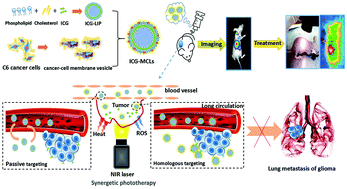Homing of ICG-loaded liposome inlaid with tumor cellular membrane to the homologous xenografts glioma eradicates the primary focus and prevents lung metastases through phototherapy†
Abstract
Currently, phototherapy initiated by local irradiation with a near-infrared (NIR) laser has emerged as a promising strategy for cancer treatment owing to its low toxicity. However, a key problem for effective phototherapy is how to specifically deliver a sufficient dose of photosensitizers to a tumor focus. Herein, indocyanine green (ICG), a United States Food and Drug Administration (US FDA)-approved photosensitizer, was first encapsulated in an inner aqueous compartment of liposome (ICG-LIP) to improve its stability. Thereafter, tumor cell membranes were isolated from native glioma cells and subsequently inlaid in the bilayer lipid membrane of ICG-LIP to construct cell-like liposomes (ICG-MCLs). ICG was easily encapsulated into the ICG-MCLs with a very high encapsulation efficiency, reaching 78.01 ± 0.72% and its concentration in the final formulation reached 200 μg mL−1. The ICG-MCLs displayed a spherical morphology with a hydrodynamic diameter (Dh) of 115.0 ± 0.5 nm, a PDI of 0.14, and a zeta potential of −11.2 ± 0.9 mV. Moreover, ICG-MCLs exhibited a good stability in terms of particle size and significantly improved the chemical stability of ICG in pH 7.4 PBS at 37 °C. In addition, the temperature of the ICG-MCLs rapidly increased to 63 °C after 10 min irradiation and this was maintained for a longer time. Owing to the cancer cell membrane associated protein, the ICG-MCLs were specifically internalized by homogenous glioma C6 cells in vitro, which resulted in the strong red fluorescence of ICG in cytoplasm. Moreover, in vivo imaging showed that the ICG-MCLs were effectively homed to the tumor site of C6 glioma-bearing Xenograft nude mice through vein injection, which resulted in the temperature of the tumor site rapidly rising, allowing the killing of tumor cells after local NIR irradiation. After treatment with the ICG-MCLs, the primary tumor focus was completely eradicated and lung metastases were effectively inhibited. In conclusion, liposomes inlaid with tumor cellular membranes may serve as an excellent nanoplatform for homologous-targeting phototherapy using ICG.



 Please wait while we load your content...
Please wait while we load your content...